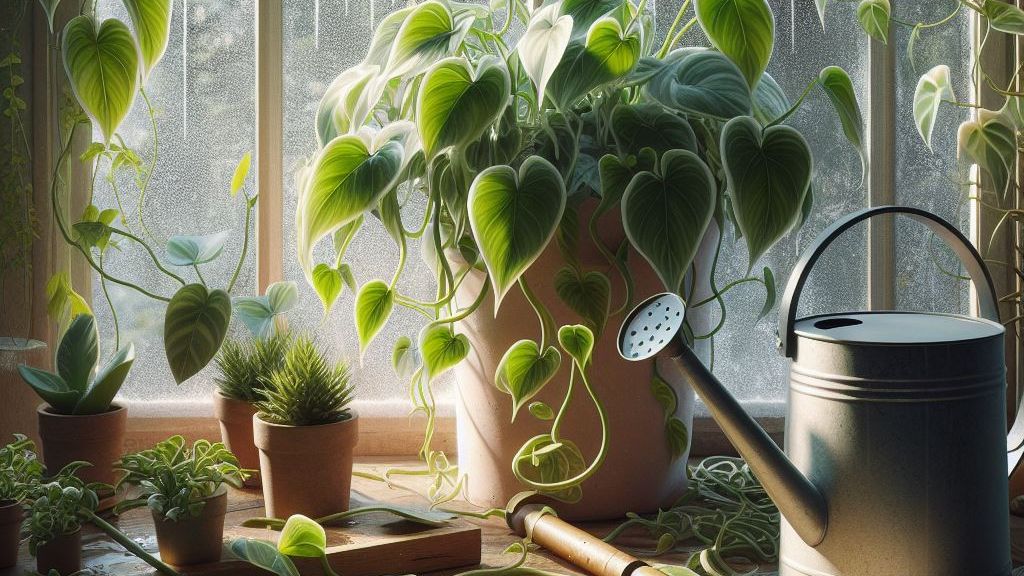Last updated on April 19th, 2024 at 08:45 am
As winter wraps its chilly embrace around us, our beloved indoor plants, like the resilient pothos, need special attention to thrive in changing conditions. One crucial aspect that plant enthusiasts often grapple with is adjusting the watering routine. In this guide, we will delve into the intricacies of pothos winter watering care, ensuring these green companions continue to flourish during the colder months.
Navigating the winter season requires understanding the specific needs of our pothos plants. The once lively leaves, flourishing in the summer’s warmth, now face challenges with reduced sunlight and colder temperatures. These changes necessitate a thoughtful adjustment to how we care for our plants. One key focus during this time is pothos winter watering care.
Contents
- 1 Understanding Pothos Winter Watering Needs
- 2 Reducing Watering Frequency
- 3 Choosing the Right Watering Technique
- 4 Monitoring Environmental Factors
- 5 Container Drainage Importance
- 6 Monitoring Light Exposure
- 7 Adjusting Watering for Plant Size
- 8 Recognizing Signs of Overwatering in Pothos Winter Watering Care
- 9 FAQs
- 9.1 Why is Pothos winter watering care crucial?
- 9.2 How do I determine when my pothos needs water in winter?
- 9.3 Can I use room-temperature water during winter for my pothos?
- 9.4 What are the signs of overwatering during Pothos winter care?
- 9.5 How do I adjust watering for different-sized pothos plants in winter?
- 9.6 Why is container drainage crucial in winter for pothos?
- 9.7 How do I optimize light exposure for my pothos during winter?
- 9.8 Why is it important to monitor humidity levels in winter?
- 9.9 What should I do if I notice signs of overwatering in my pothos during winter?
- 9.10 Can I use the same watering routine for my pothos in winter as in other seasons?
- 10 Author
Understanding Pothos Winter Watering Needs
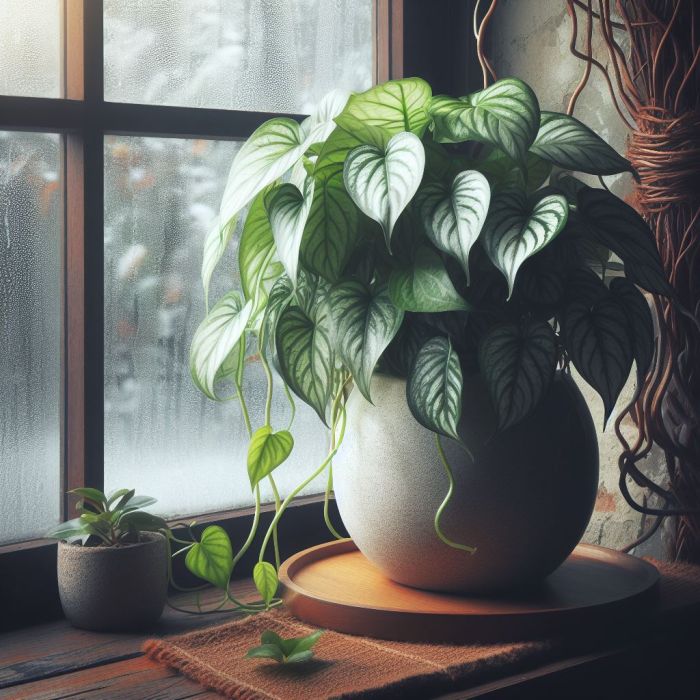
Winter brings with it reduced sunlight and lower temperatures, which significantly impact the growth rate of pothos plants. Understanding the changing needs of your plant during this season is paramount to maintaining its health and vibrancy.
To determine when your pothos needs water, there are two effective methods: the fingertip test and using a soil moisture meter.
Fingertip Test:
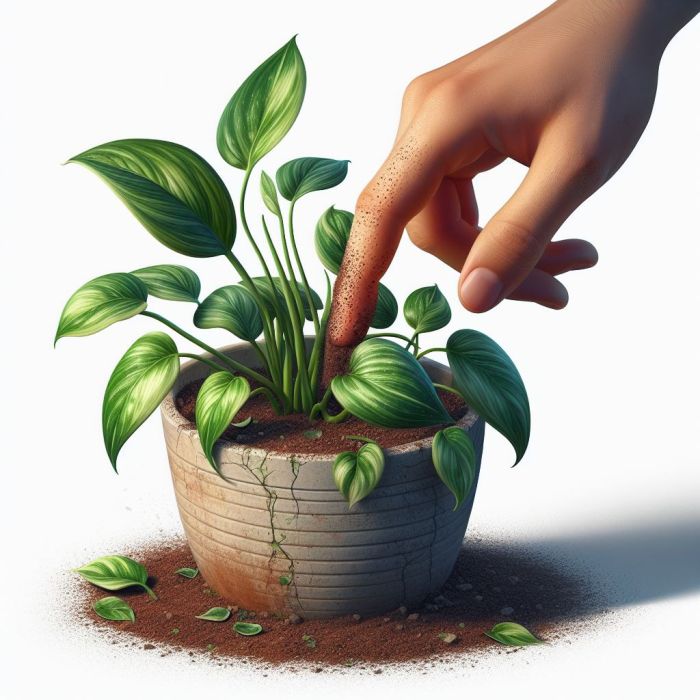
- Place your finger about an inch deep into the soil.
- If it feels dry to the touch, it’s time to water. This simple and hands-on method is a quick way to assess moisture levels and prevent overwatering, which is a common pitfall during winter.
Soil Moisture Meter:
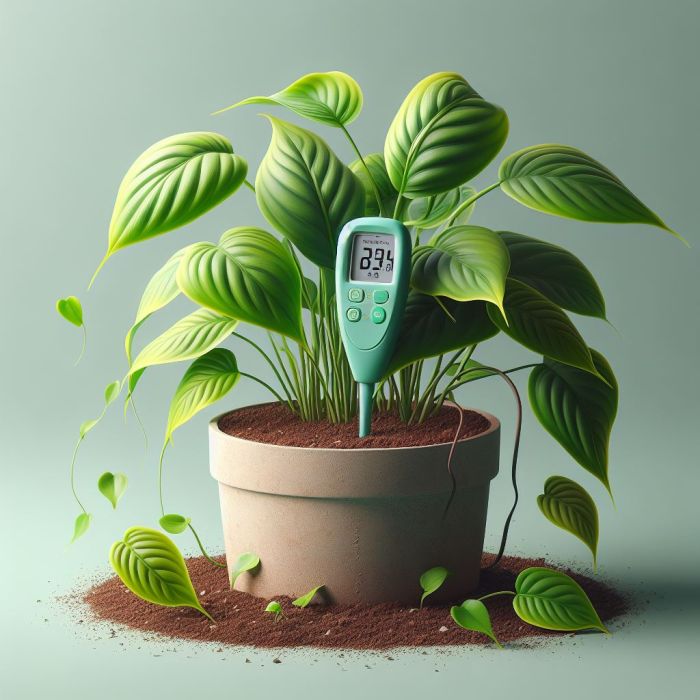
- Purchase a soil moisture meter from a garden center or online. These devices are affordable, easy to use, and available in both digital and analog varieties.
- Follow the manufacturer’s instructions to properly insert the probe into the soil of your pothos plant. Ensure that the probe reaches the root zone for an accurate reading.
- Allow the soil moisture meter a moment to register the moisture level.
- The meter will provide a digital or analog reading, usually on a scale from dry to moist to wet.
- If the meter indicates a dry soil condition, it’s time to water your pothos.
- If the soil is still moist, delay watering until the next check.
By employing both the fingertip test and a soil moisture meter, you can adjust your watering routine to better meet the specific needs of your pothos during winter. These methods help you achieve an optimal balance, ensuring the soil stays consistently moist without succumbing to the common pitfall of overwatering. This, in turn, promotes the health and well-being of your beloved plant.
Reducing Watering Frequency
In the realm of pothos winter watering care, the adjustment of watering frequency emerges as a pivotal practice. By employing both the fingertip test and a soil moisture meter, you can refine your watering routine to precisely meet the specific needs of your pothos during winter.
These methods empower you to strike an optimal balance, ensuring the soil maintains consistent moisture without succumbing to the common pitfall of overwatering. This thoughtful approach contributes to the health and well-being of your cherished plant, enhancing its resilience throughout the winter season.
Choosing the Right Watering Technique
As an integral part of Pothos winter watering care, selecting the appropriate watering technique further enhances your plant’s resilience. Consider the following tips for choosing the right watering technique during winter:
Room Temperature Water:
- Use water at room temperature to avoid shocking the plant with cold water during the colder months.
- This gentle approach helps in maintaining a stable environment for your pothos.
Gentle Watering:
- Adopt a gentle watering technique to prevent soil compaction.
- This method ensures that the water is evenly distributed without causing disruption to the soil structure.
Monitoring Environmental Factors
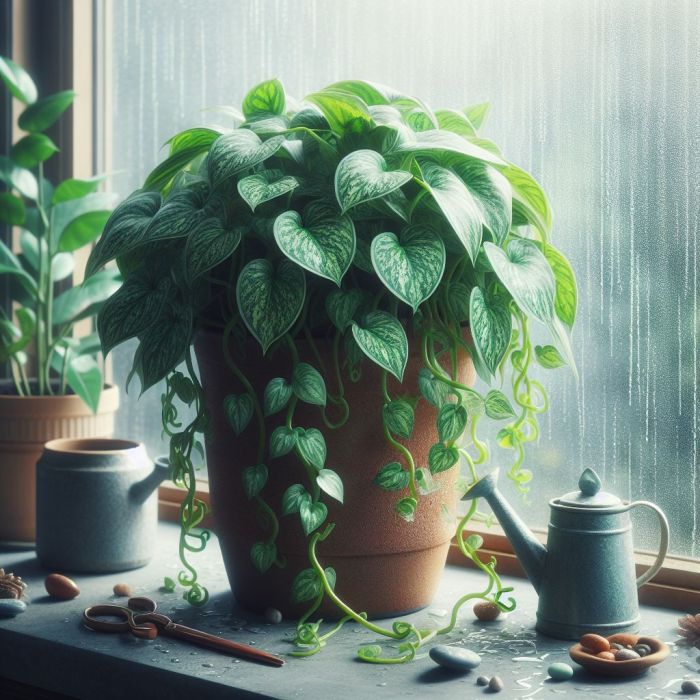
In addition to adjusting watering practices, monitoring environmental factors is crucial for effective pothos winter watering care. Consider the following key factors:
Humidity Levels:
- Be attentive to indoor humidity levels, as winter heating systems can reduce moisture in the air.
- If humidity is low, consider using a humidifier or placing a tray of water near your pothos to create a more favorable environment.
Temperature and Drafts:
- Protect your pothos from exposure to cold drafts, as sudden temperature drops can stress the plant.
- Avoid placing your pothos near windows during extremely cold nights.
Container Drainage Importance
An often overlooked yet crucial aspect of Pothos winter watering care is the importance of container drainage. Proper drainage is essential to prevent waterlogging, especially during the winter months when the plant’s growth rate is slowed. Here’s why container drainage is vital:
Preventing Water Accumulation:
- Well-draining pots and containers prevent excess water from accumulating at the bottom, reducing the risk of overwatering.
- Adequate drainage ensures that water moves away from the roots, preventing root rot—a common issue in stagnant, waterlogged conditions.
Checking Drainage Holes:
- Regularly inspect the drainage holes in your pothos’ container to ensure they are not blocked.
- Clear any obstructions to maintain proper water flow and prevent potential waterlogging issues.
Monitoring Light Exposure
In the winter months, natural light availability diminishes, requiring careful attention to your pothos’ exposure. Consider these factors to optimize light conditions:
Adjusting Placement:
- Place your pothos near bright, indirect light sources.
- Rotate the plant occasionally to ensure all sides receive adequate light.
Supplemental Lighting:
- If natural light is limited, consider using artificial grow lights.
- Position the lights at an appropriate distance to provide sufficient illumination without causing stress to the plant.
Adjusting Watering for Plant Size
Considering the size of your pothos is paramount when fine-tuning your watering routine. Different-sized plants have varying water needs, and adjusting accordingly ensures optimal care. Here’s how you can tailor your watering for different plant sizes:
Smaller Pothos:
- Smaller pothos plants typically have smaller root systems.
- Adjust your watering routine to avoid overwatering; smaller pots may dry out faster.
Larger Pothos:
- Larger pothos plants may have more extensive root systems and, consequently, greater water retention.
- Monitor soil moisture carefully and adjust watering frequency to maintain consistent moisture without waterlogging.
Recognizing Signs of Overwatering in Pothos Winter Watering Care
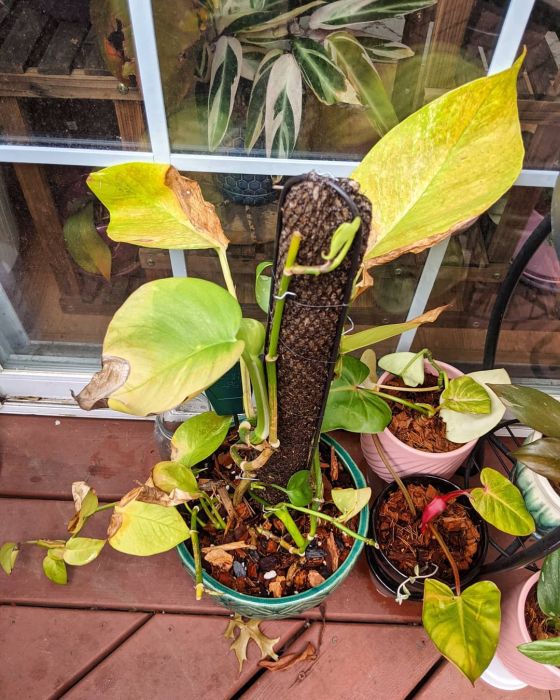
Image credit:pothoslove1
In the context of pothos winter watering care, it’s crucial to be vigilant for signs of overwatering, which can be detrimental to your plant’s health. Here are key indicators that your pothos may be receiving too much water:
Yellowing Leaves:
If the leaves of your pothos are turning yellow, especially in a pattern that starts at the tips and edges, it could indicate overwatering. Yellowing leaves may also become mushy, signaling waterlogged roots.
Wilting Despite Moist Soil:
Overwatered plants may exhibit wilting even when the soil is consistently moist. This is a sign of root damage caused by excess water, impairing the plant’s ability to take up nutrients.
Fungus and Mold Growth:
Excessive moisture promotes the growth of fungi and molds on the soil surface. If you notice black leaves or black stems, this could be an additional sign of overwatering, indicating a more advanced stage of root rot or fungal issues. Blackened areas on the plant may suggest severe damage caused by prolonged exposure to waterlogged conditions.
FAQs
Why is Pothos winter watering care crucial?
Winter brings reduced sunlight and lower temperatures, impacting the growth of pothos plants. Adapting the care routine ensures their health and vibrancy during this challenging season.
How do I determine when my pothos needs water in winter?
Use the fingertip test by placing your finger in the soil. If it feels dry, it’s time to water. Alternatively, employ a soil moisture meter for a more accurate reading.
Can I use room-temperature water during winter for my pothos?
Yes, using room temperature water helps maintain a stable environment for your pothos, avoiding shock from cold water during the colder months.
What are the signs of overwatering during Pothos winter care?
Watch for yellowing leaves, especially at the tips and edges, mushy texture, wilting despite moist soil, and the growth of fungus or mold. Black leaves or stems may indicate advanced root rot or fungal issues.
How do I adjust watering for different-sized pothos plants in winter?
Smaller pothos plants with smaller root systems may dry out faster, requiring adjusted watering. Larger pothos plants retain more water, necessitating careful monitoring and adjusted watering frequencies.
Why is container drainage crucial in winter for pothos?
Proper drainage in pots prevents water accumulation, reducing the risk of overwatering. It ensures water moves away from the roots, preventing root rot in stagnant, waterlogged conditions.
How do I optimize light exposure for my pothos during winter?
Place your pothos near bright, indirect light sources. If natural light is limited, consider supplemental lighting with artificial grow lights.
Why is it important to monitor humidity levels in winter?
Winter heating systems reduce indoor humidity, potentially affecting your pothos. Using a humidifier or placing a tray of water nearby can create a more favorable environment.
What should I do if I notice signs of overwatering in my pothos during winter?
Allow the soil to dry out before resuming a controlled watering routine. Adjust your watering practices based on the specific needs of your pothos.
Can I use the same watering routine for my pothos in winter as in other seasons?
No, winter conditions require adjustments. Employ the fingertip test and soil moisture meter to fine-tune your watering routine, preventing overwatering common in winter.
In the winter care journey for our beloved pothos, mastering the art of pothos winter watering is key. The fingertip test and a soil moisture meter are invaluable tools in maintaining the delicate balance needed for thriving plants. By adjusting winter watering frequency, choosing the right technique, and considering environmental factors, we ensure a resilient pothos through winter.
As we navigate this season, keeping a watchful eye on signs of overwatering ensures prompt intervention. In this brief guide, we equip plant enthusiasts to nurture their pothos with adaptability and strength, fostering vibrant indoor greenery that endures winter and flourishes with the arrival of spring.

